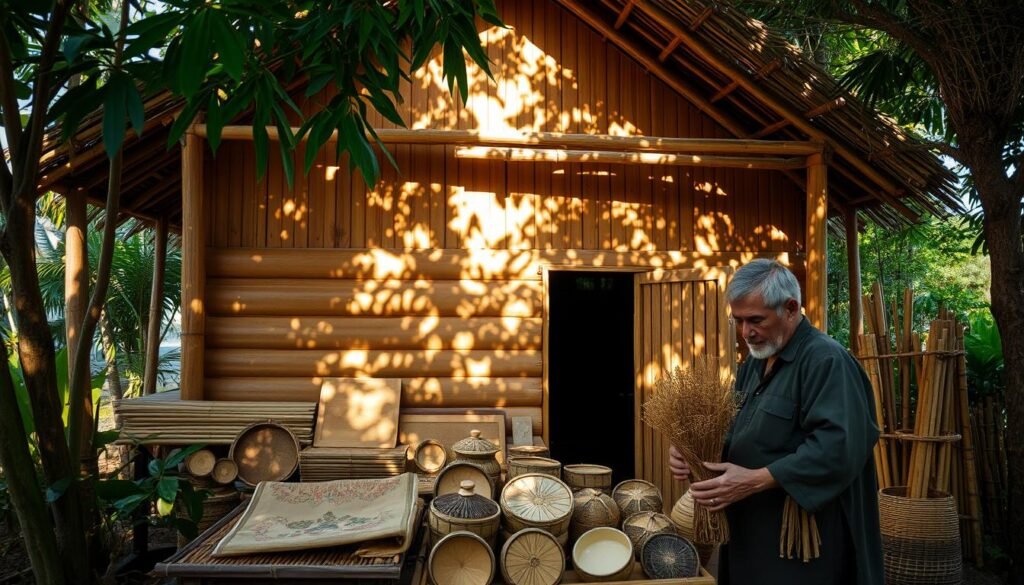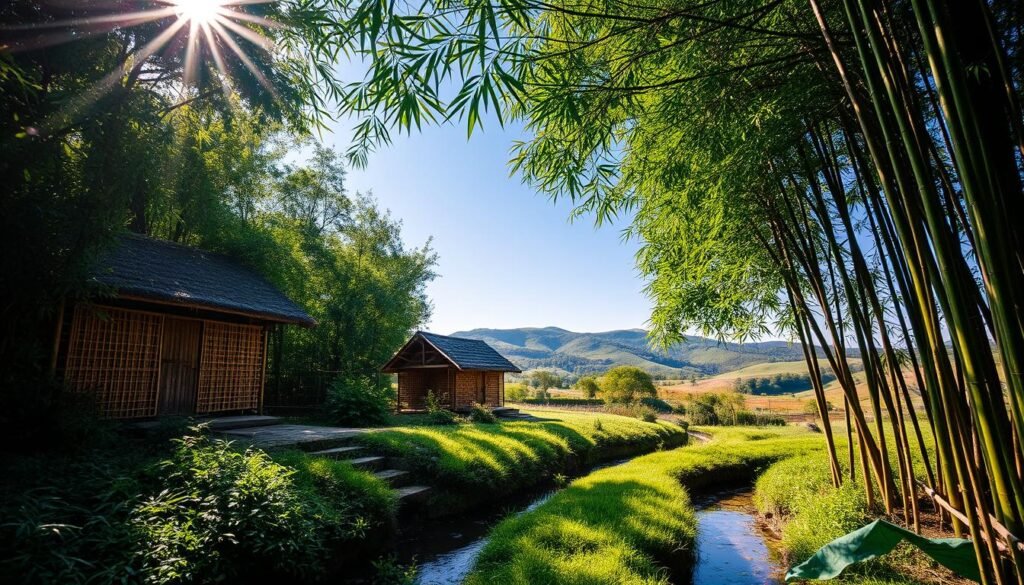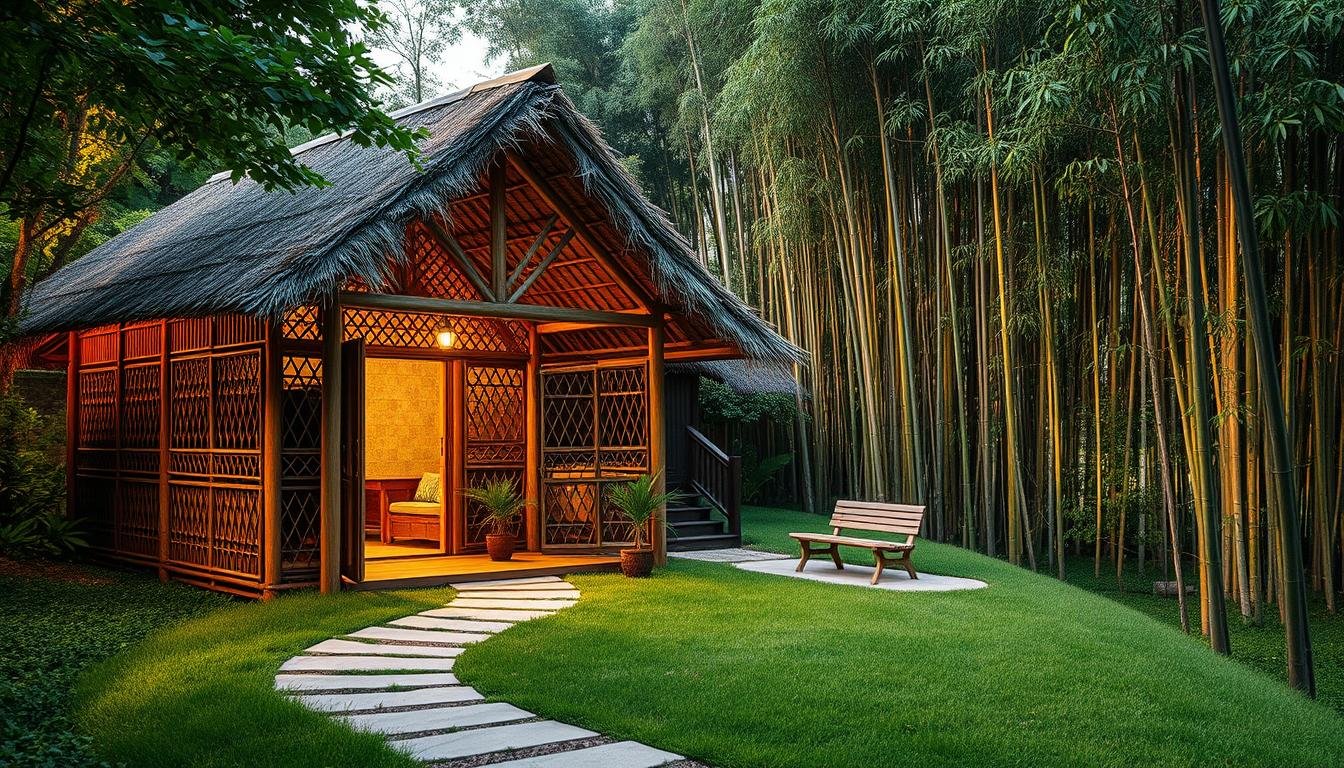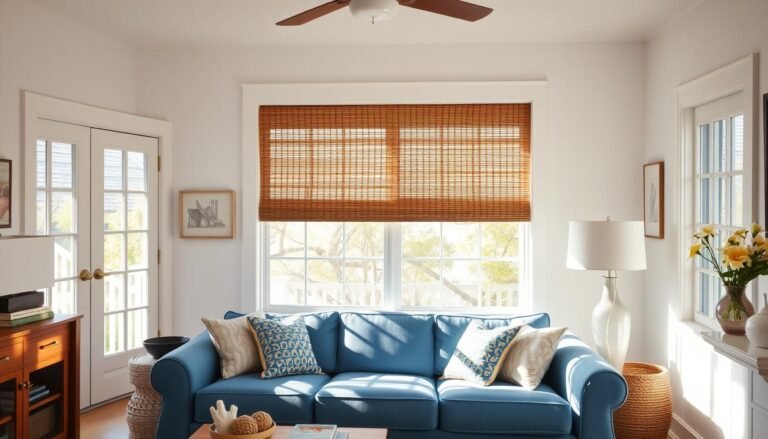Can a simple dwelling made from natural materials lead to a more sustainable future? Let’s explore traditional bamboo houses and see their eco-friendly living possibilities that have lasted for centuries.
Traditional bamboo huts mix nature and living spaces in a unique way. They offer a sustainable and durable housing solution. In this article, we’ll look at their benefits and drawbacks, prices, and how they compare to other materials.
As we explore bamboo construction, we’ll see why these dwellings are great for an eco-friendly lifestyle.
Key Takeaways
- Eco-friendly and sustainable housing solution
- Durable and long-lasting with proper maintenance
- Unique aesthetic appeal blending with nature
- Potential for cost-effectiveness in the long run
- Requires understanding of specific construction and maintenance needs
Introduction to Bamboo Huts
Bamboo huts are more than just homes; they are a way of life. They are deeply rooted in many cultures. For centuries, bamboo has been valued worldwide, mainly in Asia and Latin America, for its durability and sustainability.
What Are Bamboo Huts?
Bamboo huts are homes made from bamboo, a renewable resource. They are simple, eco-friendly, and fit well into nature. These huts can be simple shelters or complex designs, showing off different architectural styles.
Building bamboo huts uses bamboo poles, often treated for extra strength. Bamboo is lightweight, flexible, and strong. It also keeps the hut’s temperature steady, thanks to its natural insulation.
Historical Significance of Bamboo Huts
Bamboo huts have been important in many cultures for a long time. In places like Indonesia and the Philippines, bamboo has been used for homes and community buildings for centuries.
Bamboo huts are great at surviving natural disasters like earthquakes and floods. This makes bamboo a top choice in disaster-prone areas. They also play a big role in traditional ceremonies and gatherings, showing their cultural value.
Using bamboo in building is both practical and culturally significant. It reflects the values and traditions of the communities that use it.
Benefits of Bamboo Huts
Bamboo huts are eco-friendly and affordable. They are becoming popular worldwide for their many benefits.
Eco-Friendliness and Sustainability
Bamboo grows fast and needs little water and pesticides. This makes bamboo huts great for sustainable homes. Bamboo’s processing also has less environmental impact than wood or steel.
Some key eco-friendly features of bamboo huts include:
- Low carbon footprint
- Minimal environmental disruption during harvesting
- Highly renewable and sustainable
Cost-Effectiveness
Bamboo huts are not just good for the planet but also save money. Bamboo is cheaper than traditional materials. Plus, building bamboo huts is simpler, which cuts down on labor costs.
| Material | Cost per Unit | Environmental Impact |
|---|---|---|
| Bamboo | Low | Low |
| Wood | Moderate | Moderate |
| Steel | High | High |
Versatility in Design
Bamboo huts can be designed in many ways. They can be modern or traditional. Bamboo lets you create unique and useful structures.
Key design benefits include:
- Flexibility in architectural design
- Aesthetic appeal with natural beauty
- Ability to blend with various environments
Drawbacks of Bamboo Huts
Bamboo huts are sustainable but have some drawbacks. They offer many benefits, but there are also some downsides to consider when choosing bamboo as a building material.
Insect Vulnerability
Bamboo huts can be vulnerable to insects. Termites and other pests can damage the structure over time if not treated or maintained properly. Regular inspections and treatments are key to prevent this.
To fight insect damage, bamboo can be treated with natural or chemical preservatives. Some builders use borate-based treatments, which are very effective against insects.
| Treatment Type | Effectiveness Against Insects | Environmental Impact |
|---|---|---|
| Borate-based | High | Moderate |
| Chemical Preservatives | High | High |
| Natural Preservatives | Moderate | Low |
Weather Resistance Issues
Bamboo huts can face weather resistance problems if not well maintained. Heavy rain, strong winds, and extreme temperatures can harm bamboo. Regular maintenance, like sealing and protecting the bamboo, can help.
Using weather-resistant coatings and ensuring the bamboo is dried and treated can improve its weather resistance. Some builders also use design techniques that help water run off, reducing water damage risks.
Limited Availability in Certain Regions
Bamboo is not always easy to find in every area. This can make building with bamboo more expensive due to transportation costs. Local sourcing is a good option to consider.
In areas where bamboo is not native, looking into other sustainable materials or starting a local bamboo farm could be good solutions.
Price Ranges for Bamboo Huts
When thinking about a bamboo hut, knowing what affects its price is key. The cost can change a lot based on different things. It’s important to look at these factors closely.
Factors Influencing Cost
Several things can change the price of a bamboo hut. These include:
- Size: Bigger huts need more stuff, making them cost more.
- Design Complexity: Fancy designs and special features can raise the price.
- Location: Moving costs and local worker prices can change the final cost.
- Materials Quality: The quality of bamboo and other materials greatly affects the price.
Average Prices for Construction
The cost to build a bamboo hut can be from $5,000 to $50,000 or more. This depends on the factors mentioned earlier. Here’s a look at average prices for different sizes of bamboo huts:
| Size | Average Cost |
|---|---|
| Small (100 sq. ft.) | $5,000 – $10,000 |
| Medium (500 sq. ft.) | $15,000 – $30,000 |
| Large (1000 sq. ft.) | $30,000 – $50,000+ |
Cost Comparisons with Other Materials
Comparing bamboo huts to other materials shows some interesting points. Here’s a look at how they compare to traditional wood and metal structures:
| Material | Average Cost per Sq. Ft. |
|---|---|
| Bamboo | $10 – $50 |
| Wood | $15 – $70 |
| Metal | $20 – $100 |
Bamboo huts are a good deal when it comes to price. They also offer the benefit of being eco-friendly. As we look for green options, bamboo stands out as a smart and green choice.

Durability of Bamboo Huts
Bamboo huts are known for their long-lasting nature, making them a great choice for sustainable homes. We’ll look at what makes them last so long and compare them to other materials.
Lifespan of Bamboo Structures
Bamboo structures are incredibly durable. With the right care, bamboo huts can stand for many years. Bamboo naturally fights off pests and doesn’t rot easily, thanks to its strength. Keeping them well-maintained, like applying protective coatings and ensuring good airflow, can help them last even longer.
Factors influencing the lifespan of bamboo huts include:
- Quality of the bamboo used
- Design and construction techniques
- Environmental conditions
- Regular maintenance practices
Comparison with Wood and Other Materials
Bamboo outlasts wood because it naturally resists rot and insects. It doesn’t need harsh chemicals to protect it from the environment. This makes bamboo a greener choice.
Compared to polyester or metal, bamboo huts are a special mix of sustainability and toughness. Metal is strong but needs a lot of energy to make and can rust. Bamboo, being a renewable resource, is harvested with little harm to the environment.
Choosing bamboo for your hut means picking a material that’s both durable and eco-friendly. Its long life and green benefits make bamboo huts a top pick for those wanting to build sustainably.
Sustainability of Bamboo Huts
Bamboo huts are a top choice for eco-friendly homes. Bamboo is known for its low environmental impact, making it perfect for building.
Renewable Resource
Bamboo grows fast, needing little water and no pesticides. It’s ready to harvest in just three to five years, unlike wood which takes decades. This quick growth makes bamboo a sustainable alternative to wood.
We can grow bamboo without harming the environment. It keeps soil healthy and stops erosion. Plus, bamboo is often found locally, cutting down on emissions from transport.
Carbon Footprint and Environmental Impact
Bamboo is a carbon hero, absorbing more CO2 and making more oxygen than many crops. It can soak up to 12 tons of CO2 per hectare each year. This makes bamboo huts a carbon-negative choice.
Bamboo huts also have a low environmental impact. They can be built with little waste. Bamboo is easy to shape, reducing the need for extra materials and waste. This helps lower the carbon footprint even more.
| Material | Carbon Footprint (tons CO2/year) | Renewability |
|---|---|---|
| Bamboo | -12 | High |
| Traditional Wood | -2 | Low |
| Steel | +5 | Low |
The table shows bamboo has a much lower carbon footprint than wood and steel. This makes bamboo huts a great choice for those wanting to lessen their environmental impact.

Choosing bamboo huts means picking a sustainable and renewable option. It also helps cut down global carbon emissions. Bamboo is leading the way in eco-friendly construction.
Comparison with Similar Materials
When we look at sustainable building materials, bamboo stands out. We should compare it to wood, polyester, and cotton. This helps us see what makes bamboo special.
Bamboo vs. Wood
Bamboo and wood are both natural choices for building. But bamboo grows faster and is more renewable. Wood takes decades to grow, while bamboo is ready in three to five years.
Here are some key differences between bamboo and wood:
- Bamboo is more resistant to pests and decay.
- Wood requires more intensive forestry management.
- Bamboo has a lower environmental impact due to its rapid growth and carbon sequestration capabilities.
Bamboo vs. Polyester
Bamboo beats synthetic materials like polyester in eco-friendliness. Bamboo is natural and biodegradable. Polyester comes from non-renewable petroleum.
| Material | Biodegradability | Environmental Impact |
|---|---|---|
| Bamboo | Yes | Low |
| Polyester | No | High |
Bamboo vs. Cotton
Bamboo and cotton are both natural fibers. But bamboo uses less water and is pest-resistant. This means less need for pesticides.
Key advantages of bamboo over cotton include:
- Bamboo has a higher yield per acre.
- Bamboo requires less water and pesticides.
- Bamboo fabric is known for its softness and durability.
In conclusion, bamboo is better than wood, polyester, and cotton for the environment. It’s durable and sustainable. Choosing bamboo helps us go green and reduce our impact on the planet.
Care and Maintenance of Bamboo Huts
Keeping your bamboo hut in top shape is key to its long life. Regular upkeep not only keeps it looking great but also protects it from the elements.
Routine Maintenance Guidelines
To ensure your bamboo hut stays in good condition, follow these steps:
- Check the structure often for damage like cracks or splits in the bamboo.
- Use a soft brush or cloth to clean the bamboo and remove dirt.
- Apply a natural sealant or oil to protect it from moisture and bugs.
- Make sure there’s good air flow around the hut to avoid moisture buildup.
Repairing Common Issues
Even with regular care, problems can happen. Here’s how to fix common issues:
- Cracks and Splits: Use bamboo adhesive or a mix of natural resin and hardener to fix them.
- Insect Infestation: Treat affected areas with a natural insect repellent or borate-based solution.
- Weathering: Reapply a protective sealant or oil to keep the bamboo weather-resistant.
By following these care and maintenance tips, you can make your bamboo hut last longer. Enjoy its eco-friendly benefits for many years.
Popular Brands Offer Bamboo Huts
Looking for bamboo huts? There are many trusted brands to check out. They offer everything from ready-to-go kits to custom designs. This meets different needs and tastes.
International Brands
International brands have made a big splash in the bamboo hut market. Bambootech is famous for its innovative bamboo materials and prefabricated huts. Their products are green, strong, and stand up to nature.
Bamboo Living is another top name for eco-friendly bamboo homes. They have many designs and sizes. This makes it easy to find the perfect bamboo hut for you.
Local Manufacturers in the U.S.
In the U.S., local makers also offer top-notch bamboo huts. American Bamboo is known for its green focus and skilled craftsmanship. They create custom bamboo huts that fit your exact needs.
Bamboo Structures Inc. is a U.S. company that focuses on bamboo building. They have a wide range of bamboo huts, from simple to complex. All are made from eco-friendly bamboo.
| Brand | Specialty | Location |
|---|---|---|
| Bambootech | Prefabricated bamboo huts | International |
| Bamboo Living | Eco-friendly bamboo homes | International |
| American Bamboo | Custom bamboo hut designs | U.S. |
| Bamboo Structures Inc. | Bamboo construction | U.S. |
When picking a brand for your bamboo hut, think about greenness, durability, and design options. Choosing well-known brands and makers means your hut will be eco-friendly and long-lasting.
Pros and Cons of Bamboo Huts
Thinking about bamboo huts? It’s key to know their good and bad sides. Bamboo huts are loved for being eco-friendly and sustainable. Yet, they have their own set of benefits and drawbacks.
Advantages of Choosing Bamboo Huts
Bamboo huts have many pluses, making them a great pick for eco-conscious living. Here are some main benefits:
- Eco-friendliness: Bamboo is a highly renewable resource, making it an environmentally friendly choice.
- Cost-effectiveness: Compared to traditional building materials, bamboo can be more cost-effective.
- Aesthetic appeal: Bamboo huts have a unique and natural beauty that can enhance any setting.
Bamboo huts are also super versatile. They can fit many architectural styles and needs.
Disadvantages to Consider
But, there are downsides to bamboo huts too:
- Vulnerability to insects: Bamboo can be susceptible to insect damage if not properly treated.
- Weather resistance: Bamboo huts may require additional treatment to withstand harsh weather conditions.
- Limited availability: In some regions, bamboo may not be readily available, which can increase costs.
Knowing these pros and cons helps you decide if a bamboo hut is right for you.
| Feature | Advantages | Disadvantages |
|---|---|---|
| Eco-friendliness | Bamboo is renewable and sustainable | May require additional treatment for durability |
| Cost | Can be cost-effective | May be more expensive in regions where bamboo is scarce |
| Durability | Can be durable with proper treatment | Vulnerable to insects and harsh weather |
FAQs about Bamboo Huts
Exploring bamboo huts raises many questions. We tackle common bamboo house questions and construction queries. This aims to clear up the mystery around this eco-friendly housing choice.
Lifespan of Bamboo Huts
Bamboo huts can last decades with the right care. Climate, upkeep, and how well they’re built all affect their life span.
Fire Resistance
Bamboo naturally resists fire to some extent. But, it can be treated to boost its fire protection. This makes bamboo huts safer than many other flammable materials.
Customization Options
Bamboo huts can be tailored to meet your needs. We can adjust design and size to fit your lifestyle and budget. This answers many bamboo hut FAQs.
Understanding these points helps us see the value of bamboo huts. They offer a sustainable and flexible housing option.
FAQ
How long do bamboo huts last?
Bamboo huts can last for many years with the right care. Their lifespan depends on the bamboo quality, how they’re built, and regular upkeep. With proper maintenance, a bamboo hut can last for decades.
Are bamboo huts fire-resistant?
Yes, bamboo huts can be made fire-resistant. Bamboo itself is flammable, but treatments like borate solutions can help. Always check local fire safety laws when building.
Can bamboo huts be customized?
Absolutely, bamboo huts can be tailored to your needs. Many makers offer custom designs, letting you pick size, layout, and features. You can even add modern comforts for better living.
What are the benefits of bamboo construction?
Bamboo construction is green, affordable, and long-lasting. Bamboo grows fast, needs little water and pesticides, making it eco-friendly. Plus, bamboo huts can look great and be very versatile.
How do I maintain a bamboo hut?
Keeping a bamboo hut in good shape is key. Protect it from bugs and weather, check it often, and fix any issues quickly. A protective coating can also help keep the bamboo strong.
Are bamboo houses suitable for all climates?
Bamboo houses work well in many climates, but it depends on the area and upkeep. In wet or extreme weather, extra care and treatments might be needed to keep the bamboo durable.
How do bamboo huts compare to traditional housing materials?
Bamboo huts have big advantages over traditional materials like wood or steel. They’re better for the environment and can save money. But, bamboo huts might need more upkeep than regular houses.




